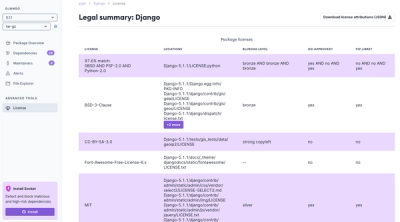
Product
Introducing License Enforcement in Socket
Ensure open-source compliance with Socket’s License Enforcement Beta. Set up your License Policy and secure your software!
This is a loader script for web components that were written down in HTML, as they should be! It listens for changes in DOM, and when it detects a custom element, it fetches its markup and inserts it in the DOM. Its name comes from Custom Element LOader and from the fact that good names in NPM are hard to get.
Celo will autoload the web component for you if your follow the rules:
You can have multiple components in a single html file, but you should only do it if you have a main component with one or more subcomponents. Think of a subcomponent as:
Subcomponents are separated from their masters only for clarity. If you add the subcomponent tag to your html, Celo will try to load it from a file matching its tagName, resulting in an error.
Celo uses a MutationObserver to listen for any element inserted in the DOM that carries a hyphen (ie. a custom element). Upon detection, it checks if that component has already been used. If it is a new component, it will fetch the markup and add its code to a hidden div with an id of "#_celo".
In order to separate markup from code within your component, Celo uses regex instead of parsing the whole thing. Currently it assumes all .
Celo has no dependencies, but the non-minified version assumes ES6.
Here's how a "simple-example.html" file could look like (I'm not advocating this is the right way to do it, just stating that it works):
<template id="tpl-simple-example">
<div>
<p>This is a demo web component.</p>
</div>
<style>
p{
padding: 5px 10px;
background-color: antiquewhite;
}
</style>
</template>
<script>
class SimpleExample extends HTMLElement{
constructor(){
super()
const el = document.querySelector("#tpl-simple-example")
.content.cloneNode(true)
this.attachShadow({mode:'open'}).appendChild( el )
}
}
customElements.define( 'simple-example',SimpleExample )
</script>
FAQs
A loader for HTML-based web components.
The npm package celo receives a total of 5 weekly downloads. As such, celo popularity was classified as not popular.
We found that celo demonstrated a not healthy version release cadence and project activity because the last version was released a year ago. It has 1 open source maintainer collaborating on the project.
Did you know?

Socket for GitHub automatically highlights issues in each pull request and monitors the health of all your open source dependencies. Discover the contents of your packages and block harmful activity before you install or update your dependencies.

Product
Ensure open-source compliance with Socket’s License Enforcement Beta. Set up your License Policy and secure your software!

Product
We're launching a new set of license analysis and compliance features for analyzing, managing, and complying with licenses across a range of supported languages and ecosystems.

Product
We're excited to introduce Socket Optimize, a powerful CLI command to secure open source dependencies with tested, optimized package overrides.